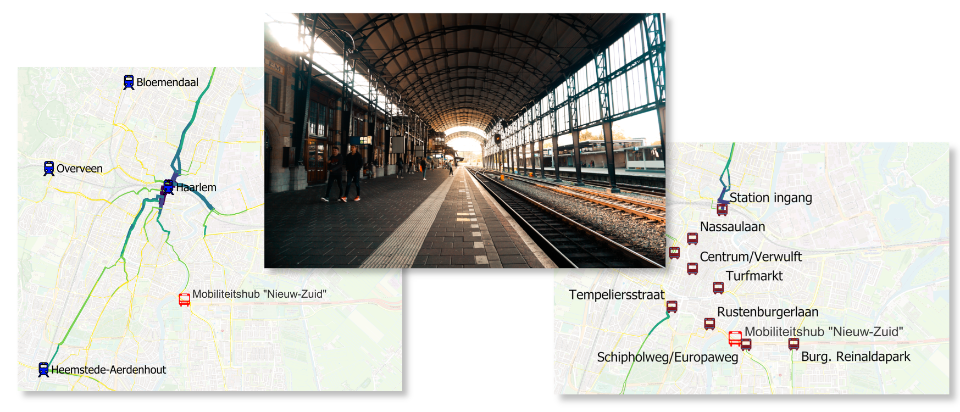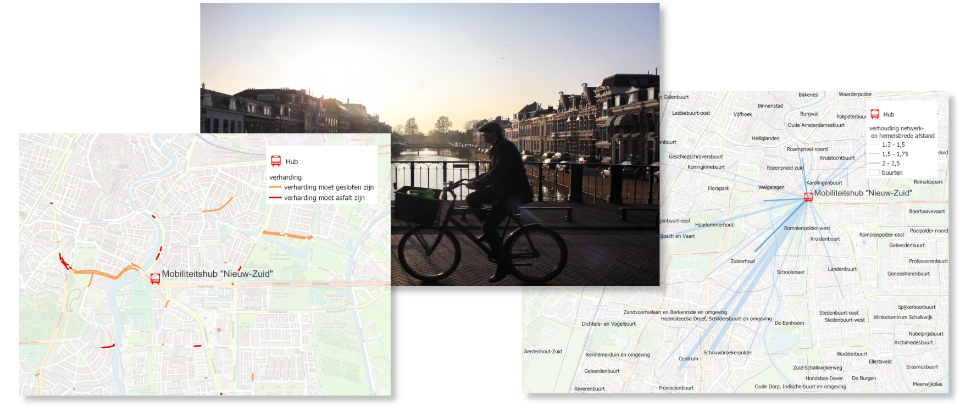Inventory bottlenecks for mobility-hub Haarlem with the Bicycle Traffic Monitor
Municipality of Haarlem

The municipality of Haarlem is working on a new mobility hub called 'Nieuw-Zuid'. Besides about 2,000 new homes, there will also be several shops and a regional mobility hub. The hub will include an underground bicycle parking facility with 2,500 spaces. The hub's design incorporates the cycling infrastructure in the immediate area. But bicycle trips extend beyond the immediate vicinity of the hub. The Bicycle Monitor was used for the design to determine potential bottlenecks in the new bicycle traffic to and from the hub.
Data-driven approach with FietsMonitor
To systematically identify the potential bottlenecks, a data-driven analysis was carried out. The Bicycle Monitor has been the basis for this. For relevant train stations and bus stops, the following questions were answered:
- How many cyclists come from there?
- How many cyclists go there?
- Where do the cyclists come from?
- What routes do the cyclists then take?
Growth scenarios for the new mobility hub were then determined by the municipality. Based on these scenarios, Witteveen+Bos used the FietsMonitor to identify potential bicycle bottlenecks in terms of capacity, flow, comfort, safety and missing links.
Bicycle flows to and from train stations and bus stops
Bicycle flows to and from train stations in Haarlem have been determined by using the following data, among others:
1. The number of people entering and leaving each station per day
2. The share of the bicycle in the so-called 'before and after transport' of public transport (data from the Dutch Railways)
3. The distances cyclists make/cycle to and from the station before the train ride (data from OnDerweg in Nederland (ODiN)).
For bicycle flows to bus stops, the number of bicycle-bus trips was first determined and bicycle routes were determined based on the trip length distribution (ODiN).

Thus, specific insight has been generated into bicycle trips to and from train stations and bus stops. In combination with the bicycle flows from the Bicycle Monitor Haarlem, the total bicycle flow was determined.
Future bicycle flows to the mobility hub
With the development of urban hub Nieuw-Zuid and the mobility hub, it is expected that bicycle flows to and from the new hub will change. Three scenarios have been defined for the future situation, incorporating both the new mobility hub and general growth in bicycle traffic. This results in an overview of important bicycle flows to and from the mobility hub in relation to existing bicycle traffic in Haarlem. The Bicycle Monitor has identified new bicycle flows and potential new and/or exacerbated bottlenecks in the Haarlem bicycle network.
Potential bottlenecks mapped
The analysis of potential bottlenecks identifies five aspects:
1. Capacity
2. Comfort
3. Flow
4. Safety
5. Missing links
Based on these aspects, a bottleneck analysis was made for existing and/or new bottlenecks in the new bicycle flows. This analysis was carried out for the cycle routes where a growth in bicycle traffic through the new mobility hub is expected.
In terms of comfort, it was determined that the bicycle facilities west of the new mobility hub, in particular, do not meet the desirable pavement type. The analysis of missing links shows that particularly the connection to the south of Haarlem and Heemstede is poor and may be missing a link there.

An increased desire for insight
The Municipality of Haarlem has received the help it needed for its bicycle action plan. The Bicycle Traffic Monitor was cited as its data-driven foundation. During the process, the municipality learned that data provides many opportunities to gain new insights and support existing measures.
Witteveen+Bos and the Municipality of Haarlem have since begun discussing further possibilities. Whereas the Bicycle Traffic Monitor was initially intended to visualise existing data (descriptive), work is now being done on using it to provide insight into the effects of potential policy measures (predictive). We are currently busy developing a function that will allow the municipality to analyse the effects of changes to the bicycle network, such as the construction or improvement of bicycle connections.
The Bicycle Traffic Monitor
The Bicycle Traffic Monitor helps use data to map out bicycle traffic, identify bottlenecks and determine the impact of measures.


More information?

Sander, a traffic data scientist, is the Bicycle Traffic Monitor's inventor, developer and product owner.